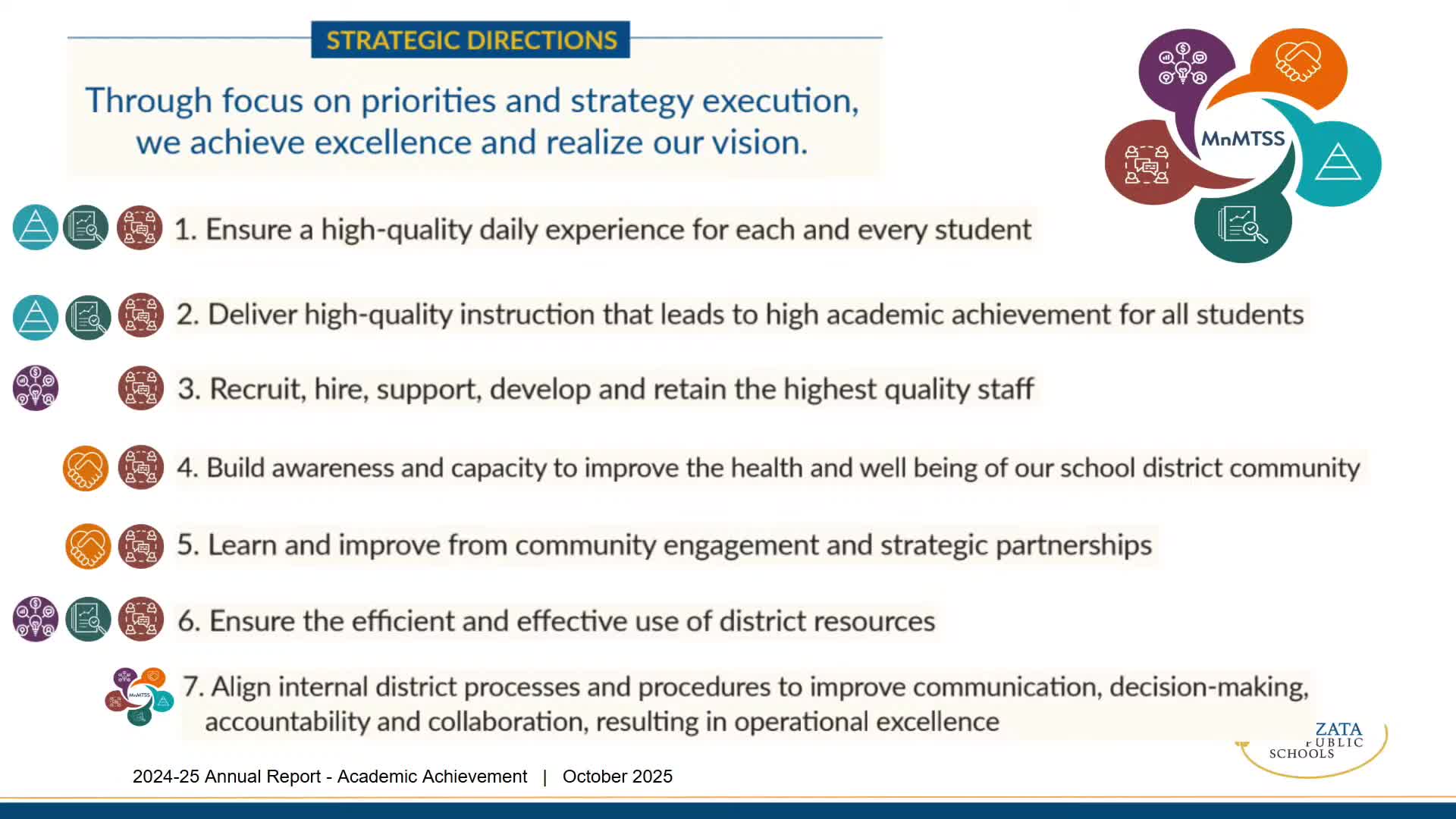Wayzata presents MCA, FastBridge and intervention plans; district reports declines since 2021–22 but outlines staffing and data‑system responses
October 28, 2025 | Wayzata Public School District, School Boards, Minnesota
This article was created by AI summarizing key points discussed. AI makes mistakes, so for full details and context, please refer to the video of the full meeting. Please report any errors so we can fix them. Report an error »

District staff presented results from state MCAs and FastBridge classroom screening and described the district’s instructional responses and new data tools.
Stacy (district teaching-and-learning staff) and Dana (district staff) summarized assessment trends: reading and math proficiency percentages for grades 3–8 have fallen compared with 2021–22 but have stabilized in recent years. For reading the district reported 71 percent proficient in 2024–25 (grades 3–8). Staff said that compared with 2021–22 every racial/ethnic group declined about 4–6 percentage points and that the gap between the highest‑ and lowest‑performing groups has remained at about 40 percentage points over the last four years. In math staff reported broader decreases, with the largest 2024–25 gap at 54 points.
District staff emphasized that the MCAs and FastBridge measure different things: MCA results are aligned to Minnesota state standards and are used for system‑level benchmarking across years; FastBridge provides formative, classroom‑level information on student growth. The presenters noted high school participation in MCAs has been a statewide challenge; at Wayzata, participation rates vary by subgroup (for example, 10th‑grade Asian students showed 95% participation in one year’s data; other groups were lower).
Staff described concrete interventions and system changes already underway: two full‑time elementary literacy coaches, seven part‑time literacy coaches deployed by need, a policy that literacy‑specialist supports “follow the student,” Orton‑Gillingham training for all kindergarten and first‑grade teachers and optional training for second grade, direct use of Read 180 for intensive reading support at the secondary level, and reinstatement of five elementary math specialists this year.
To improve data access and decision making the district said it purchased a data‑visualization platform called Aubrey. District staff said Aubrey will combine multiple data sources so principals and instructional teams can monitor progress, spot patterns across buildings, and target Tier 2 and Tier 3 interventions more quickly; three buildings were listed as pilot sites with a broader rollout targeted for January.
Board members asked for clarifications about cohort tracking, participation, and what “proficient” means on the MCA. Staff explained that cohort analyses are complicated by moving‑in/moving‑out and by the way the FastBridge “summer high‑risk” cohort is defined, and that MCA proficiency cut scores are set by the Minnesota Department of Education on a three‑digit scale (e.g., a typical cut score example given was 350 for third grade on that grade’s scale, with ranges changing by grade). Staff also discussed grading and credit versus demonstrated learning during a broader discussion about graduation and literacy.
Ending: District leaders said the results are the first step; they framed the next steps as setting 2025–26 measurable goals (using assessment data just collected), expanding Aubrey use, continuing Orton‑Gillingham training and literacy coaching, and monitoring the effectiveness of Read 180 and the reinstated math specialists.
Stacy (district teaching-and-learning staff) and Dana (district staff) summarized assessment trends: reading and math proficiency percentages for grades 3–8 have fallen compared with 2021–22 but have stabilized in recent years. For reading the district reported 71 percent proficient in 2024–25 (grades 3–8). Staff said that compared with 2021–22 every racial/ethnic group declined about 4–6 percentage points and that the gap between the highest‑ and lowest‑performing groups has remained at about 40 percentage points over the last four years. In math staff reported broader decreases, with the largest 2024–25 gap at 54 points.
District staff emphasized that the MCAs and FastBridge measure different things: MCA results are aligned to Minnesota state standards and are used for system‑level benchmarking across years; FastBridge provides formative, classroom‑level information on student growth. The presenters noted high school participation in MCAs has been a statewide challenge; at Wayzata, participation rates vary by subgroup (for example, 10th‑grade Asian students showed 95% participation in one year’s data; other groups were lower).
Staff described concrete interventions and system changes already underway: two full‑time elementary literacy coaches, seven part‑time literacy coaches deployed by need, a policy that literacy‑specialist supports “follow the student,” Orton‑Gillingham training for all kindergarten and first‑grade teachers and optional training for second grade, direct use of Read 180 for intensive reading support at the secondary level, and reinstatement of five elementary math specialists this year.
To improve data access and decision making the district said it purchased a data‑visualization platform called Aubrey. District staff said Aubrey will combine multiple data sources so principals and instructional teams can monitor progress, spot patterns across buildings, and target Tier 2 and Tier 3 interventions more quickly; three buildings were listed as pilot sites with a broader rollout targeted for January.
Board members asked for clarifications about cohort tracking, participation, and what “proficient” means on the MCA. Staff explained that cohort analyses are complicated by moving‑in/moving‑out and by the way the FastBridge “summer high‑risk” cohort is defined, and that MCA proficiency cut scores are set by the Minnesota Department of Education on a three‑digit scale (e.g., a typical cut score example given was 350 for third grade on that grade’s scale, with ranges changing by grade). Staff also discussed grading and credit versus demonstrated learning during a broader discussion about graduation and literacy.
Ending: District leaders said the results are the first step; they framed the next steps as setting 2025–26 measurable goals (using assessment data just collected), expanding Aubrey use, continuing Orton‑Gillingham training and literacy coaching, and monitoring the effectiveness of Read 180 and the reinstated math specialists.
View full meeting
This article is based on a recent meeting—watch the full video and explore the complete transcript for deeper insights into the discussion.
View full meeting
